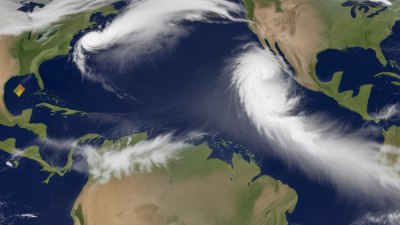Why the Forecast Only Lies When You Plan Something Cute
Explore why weather forecasts often seem inaccurate when you're planning something adorable, from science to superstition.

It's a common joke among many: the weather forecast always seems to fail exactly when you have planned something cute or special. Whether it's a picnic in the park, a photoshoot for adorable pets, or an outdoor activity with loved ones dressed up in their best outfits, the prediction of sunshine or clear skies suddenly turns into surprise rain or unexpected clouds. This phenomenon, while often dismissed as coincidence, has intrigued many and deserves a closer look into why it feels like forecasts lie precisely at these moments.
Weather forecasting is a complex science that attempts to predict atmospheric conditions based on data collected from a wide range of sources including satellites, radar, ground stations, and balloons. Meteorologists use supercomputers and sophisticated models to analyze this data and generate forecasts. Despite monumental technological advances, weather prediction remains inherently uncertain due to the chaotic nature of the atmosphere.
The Science Behind Weather Forecasting Limitations
Weather prediction involves simulating atmospheric behavior over time. Due to the atmosphere being a chaotic system, small errors or uncertainties in initial data can exponentially grow, making long-term forecasts especially difficult. Short-term forecasts (1-3 days) tend to be more accurate since less time allows for fewer deviations. However, even short-term forecasts can be thrown off by sudden, localized weather phenomena.
When planning events perceived as 'cute' or special, people often look ahead several days to weeks, hoping for perfect weather. This longer horizon increases the chance that forecasts may change and may not be accurate at the time of the event. Moreover, weather conditions such as temperature, lighting, and cloud cover, which impact the ambiance of 'cute' plans, often vary rapidly in ways models cannot fully capture.
The Psychological Bias: Confirmation and Expectation
One major reason forecasts seem to 'lie' only when planning something cute is rooted in human psychology. Confirmation bias causes individuals to notice and remember events that fit their beliefs or expectations more intensely. If someone hopes for perfect weather for a cute picnic but gets rain, that unpleasant surprise sticks in memory more vividly than all the accurate forecasts on other days.
In addition, expectation plays a role. When preparing for an event emphasizing aesthetics or sentimentality, people become more attuned to changes in weather. A cloudy sky or sudden drizzle impacts the emotional tone of the event, making the supposed inaccuracy of the forecast feel personal or purposeful. This emotional link strengthens the perception that the forecast 'lies' exclusively for these events.
Random Chance and Probability
Statistically, weather forecasts have a reliability rate that varies based on location, season, and forecast horizon. Even the best models have probabilities rather than certainties — for example, a 70% chance of sunshine still allows for a 30% chance of clouds or rain. Over many events, unlucky timing may create a pattern of perceived bad weather during desired cute activities.
This randomness does not mean deception but underscores the limits of prediction. Many pleasant days pass without incident, but those that do contradict expectations disproportionately affect our perception of forecast reliability when planning special moments. It is a reminder that weather is not under human control, and forecasts inherently carry risk.
Technology and Improvements in Forecasting
Despite inherent challenges, forecasting technology continues to improve with advances in data collection, computational power, and modeling techniques. High-resolution models enable better understanding of localized effects, and machine learning increasingly assists in pattern recognition. Satellite imagery combined with real-time observations also enhances short-term predictions organically.
Planners can mitigate uncertainty by using updated forecasts closer to their planned event, choosing flexible dates, or preparing contingencies such as tents or indoor alternatives. Mobile weather apps provide minute-by-minute updates that allow quick responses to weather changes, reducing frustration linked to forecast discrepancies.
Cultural and Social Interpretations
Weather influences not just practical activities but cultural and social moods. The 'cute event weather curse' morphs into a shared joke or superstition in communities. Stories of rain spoiling birthday parties or cloud cover hiding perfect sunsets circulate widely, reinforcing the belief that the forecast is somehow conspiring against well-intentioned plans.
This cultural narrative may spread through social media where people share their disappointment and ironically highlight forecast mistakes on days earmarked for special events. While meant humorously, these stories embed deeper emotional resonance about the unpredictability of nature juxtaposed with human desires for control and perfection.
Tips for Dealing with Forecast Uncertainty During Cute Plans
Understanding the interplay of meteorology, psychology, and chance can help individuals better cope with forecast uncertainty when planning cherished activities. Here are some practical tips:
- Check multiple weather sources to get a consensus view instead of relying on a single forecast.
- Monitor updated short-term forecasts close to the event day for better accuracy.
- Have backup plans or indoor options ready in case of poor weather.
- Embrace the unpredictability as part of the experience rather than a failure.
- Use weather-resistant accessories like umbrellas or canopies that do not detract from the event's aesthetic.
- Capture memories regardless of weather conditions; sometimes rain can add a unique charm to photos or gatherings.
Why Enjoying the Moment Trumps Perfect Conditions
While perfect weather certainly helps occasional photo-perfect moments and outdoor gatherings, the core value of these events lies in the experience, connection, and joy shared by participants. A rain shower during a pet photoshoot or a cloudy sky on a picnic may initially feel disappointing but often becomes a memorable and funny story in hindsight.
Adaptive planning and positive attitudes support the best outcomes. The unexpected changes force creativity and show flexibility, ultimately enriching the event beyond what a perfectly predictable sunny day could offer. Nature’s unpredictability reminds us we're part of a dynamic world where imperfection forms beauty.
Thus, the attitude toward forecasts lying when planning something cute should shift from frustration to acceptance. Rather than blaming meteorological science or fate, appreciating the genuine spontaneity and embracing the moment’s authenticity creates lasting, meaningful memories.
Examples and Anecdotes from Everyday Life
Many can relate to stories where a forecast promised sunny skies for an outdoor wedding or engagement shoot, but clouds rolled in unexpectedly. Some found these moments gave softer lighting, ideal for portraits. Others recall surprise rainfall during styled birthday parties that brought everyone closer under shelters, strengthening bonds.
Even professional event planners recognize the gamble inherent in weather predictions, often factoring weather risk insurance or flexible schedules as standard. These experiences emphasize that no forecast deception occurs; rather, the complexity and inherent uncertainty remain challenges to navigate creatively.
Forecasts and Outdoor Photoshoots of Cute Themes
Photography focused on cute themes—babies, pets, couples, or whimsical props—relies heavily on good weather for lighting and mood. Forecast changes challenge photographers to adapt on the fly with artificial lighting or indoor setups. Advances in portable equipment help mitigate some risks, lowering dependency on perfect weather.
Some photographers even embrace overcast conditions for their unique, diffused light that avoids sharp shadows, creating flattering effects. Hence, weather unpredictability encourages artistic innovation rather than limiting opportunity.
The Social Media Amplification Effect
In the age of social media, experiences with weather impact on cute plans get amplified. Viral posts about a ruined picnic or sudden downpour at an engagement party spread widely, contributing to the common narrative that forecasts 'lie only for cute events.' This amplification can skew perception over time, making it feel like an epidemic of misfortune.
However, countless unaffected events do not receive equal attention, and positive outcomes rarely become viral. This discrepancy further deepens the cognitive bias linking forecast failures specifically with moments deemed important or cute.
Final Insights on Forecasts and Special Plans
The science behind weather forecasting reveals no intention to mislead; limitations and uncertainties are natural given atmospheric complexity. Human psychology and social storytelling accentuate perceived forecast failures exactly when hopes are highest. Statistical probabilities mean occasional weather surprises are inevitable, especially over longer planning horizons.
Ultimately, marrying realistic expectations with flexibility and optimism ensures that events—no matter their cuteness or significance—can be successful even if the forecast proves imperfect. Embracing unpredictability enriches experiences and preserves the magic of moments shared outdoors, beyond what any forecast alone can guarantee.











